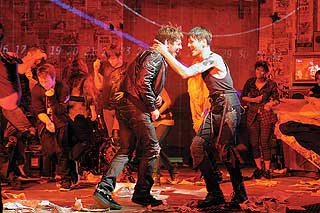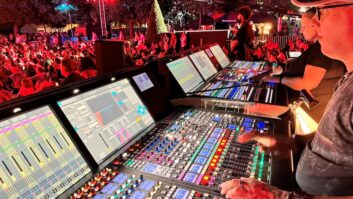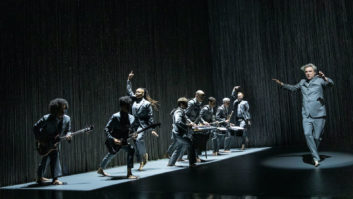
Johnny (John Gallagher Jr.) and St. Jimmy begin their “drug-induced” friendship.
Photo: Courtesy Mellopix.com
“Don’t wanna be an American idiot/Don’t want a nation under the new media/And can you hear the sound of hysteria?/The subliminal mind-f*** America.”
So begins the song “American Idiot” from Green Day’s 2004 album of the same name — a brilliant conceptual punk odyssey that grabbed post-9/11 American teens (and adults) with such inescapable songs as that title cut, “Boulevard of Broken Dreams” and “Holiday” on the radio. Now, that album’s fervor and tumult have been compellingly translated to the stage. This past fall, a de facto rock opera called American Idiot enjoyed a highly successful run on Berkeley Repertory Theatre’s Roda stage — just a stone’s throw away from 924 Gilman St., the club where the band got its start some 20 years ago.
The musical of American Idiot tells the story of a character named Johnny who is desperate to escape the boredom of his suburban life, so he flees to the city, where he expands his mind with drugs (creating the drug-dealing alter-ego St. Jimmy) and pursues the woman of his dreams, “Whatsername.” The story also follows two of Johnny’s buddies: Tunny, who enlists in the army, is injured in war and falls in love with a military nurse; and Will, who had planned on joining Johnny in the city only to learn that his girlfriend is pregnant, so instead his escape is to take up residence on his couch with his trusty beer, driving the mother of his child away.

Mix engineer David Dignazio at the Yamaha PM1D inside Berkeley Rep
As staged at Berkeley Rep, the enormous, four-story stage was wallpapered with hundreds of posters advertising punk rock shows that took place in the Bay Area through the years, and dozens of flat-screen TVs blared out news footage and other images in an overwhelming media overload. Meanwhile, a stellar company of young actors sang, danced, throbbed and head-banged to songs from American Idiot (as well as a handful of tunes from Green Day’s more recent 21st Century Breakdown, and some rare cuts); and an eight-piece band, mostly right onstage just behind the action, kept the energy high and the action moving straight through the show’s 95-minute running time.
‘Awakening’ the Idiot
For the Rep’s production, director Michael Mayer brought in some of the same team that staged Broadway’s Spring Awakening (Tony winner for Best Musical), including sound designer Brian Ronan. “I’m fortunate in that I’m on Michael’s call list,” Ronan says. “We’ve worked together many times. He’s great at letting me know about the challenges that lay ahead. Our relationship is such that he knew I’d work it through; most of his direction came in real time in the theater.”
Ronan was charged with transferring studio tracks to the stage, which can be a difficult proposition, and in this case Ronan did not meet with Green Day prior to production, so there was little direction from the band on that end. However, as production began, Ronan was impressed with the band’s involvement. “I’d have thought with all their success and wide reach that they might consider a theater piece small change, but that was not the case,” he recalls. “Tre Cool and Mike Dirnt were actively involved with the show’s drummer and bassist, respectively. They both donated instruments that would have been out of the budget of a regional theater production, and worked with the guys to share insights into their licks. And [Green Day leader] Billie Joe Armstrong was extremely present; he and Michael transformed the album content into a stage production. He also worked with our guitarist on style and interpretation and he, too, donated gear: One day, about a dozen of some of the sweetest guitars I’ve ever seen showed up at the theater for our use from his personal collection.”

Sound designer Brian Ronan (left) and David Dignazio at the premiere
Ronan notes that musicians coming into a theater production sometimes bring in expectations from tours that do not equate to a theater situation, and so there needs to be an adjustment period. “The quickest way for Green Day to feel secure was to have their trusted managers and engineers come by and check up on the show,” Ronan says. “Before the first preview, their recording engineer came by and tweaked some of the instruments to sound like the record. We learned that what was spot-on for the album was not a perfect fit for our live show. Their FOH engineer came by later that week and we worked together to EQ some of the instruments to give them the breadth they needed to be more applicable to the live show.”
Expanding for the Cast
In any album-turned-rock-opera, the sound designer must “expand” the range and tonality of select tracks so that they can be sung by a company (in this case, 19 cast members), and match the actors and their vocal ranges. Tom Kitt handled orchestrations, arrangements and music supervision, while Carmel Dean is credited as music director. Ronan notes that mix engineer David Dignazio then took the vocal arrangements and “mixed them superbly. I supported him sonically by choosing reverbs [Lexicon TC3000s on vocals] that fit the various songs.”
Dignazio, who previously mixed Shrek: The Musical and other shows on Broadway, says of working with Ronan: “He’s amazing. He’s got a fantastic ear, which is always something great. He’s got a really even-keeled disposition, which is necessary in this high-stress business: People want something, and they want it now. He has a big-picture mentality, as well, and he gave me the freedom and trust, which as a mixer I appreciate.”
Ronan’s overall vision for the sound design was to capture the power of the music and the songs. “Every musical has a voice of its own, and American Idiot‘s had to bring a level of strength and anger that would match the characters,” he says. “I’m not referring to sheer volume; 90 minutes of a loud show is draining on the ears. It was important for me to arrive at strong levels that were felt in the chest, as much as the ears. It was imperative for me to make sure the vocal level cut through the band mix. Without the words, the story of American Idiot would be lost and the audience won’t connect with the show.”
Dignazio agrees: “The most important element in Broadway mixing is lyrics because the lyrics tell the story. And if people can’t hear the words, then they have nothing to go on; that’s the vessel, the vehicle. So the implementation and the challenge is how to take a rock musical, where you want to put rock-level energy into it with musicians onstage, and be able to get the vocals to a place that is loud enough where people can discernibly hear what they’re saying, and be powerful enough to have that rock ‘n’ roll element. At the same time, there are moments in the show that are tender and quiet. So we need to create moments of gentleness, as well.”
To achieve this, Dignazio and Ronan worked on laying out a Yamaha PM1D board and coming up with the programming and tweaking as needed during rehearsals. “When we started to map the physical production to see how his design elements were implemented into what I was doing mix-wise — what worked, what didn’t — he would give me notes, things he heard at different places in the house,” Dignazio says. “As a Broadway engineer, stuff is coming at you so fast the first time that you’re reacting on-the-fly, so it’s a great thing to have Brian there to hear everything that’s going on as you’re reacting.” Dignazio used CueLab as his outboard-based program: He had an outboard Go button to fire CueLab so it sent a MIDI signal to the Yamaha board to constantly change scenes.
Musicians Everywhere!
Part and parcel of working on the sound design for any theater show is the amount of collaboration between the various departments and how decisions in one department can affect the sound design. For instance, audiences will notice that there is no standard orchestra pit; instead, four of the musicians (strings and drums) are seated on different tiers of the set, the violinist as high up as a four stories. When asked how this arrangement molded his design, Ronan replies, “To make my job much, much harder! It was really done to fit into the expanse of Christine Jones’ set. The landscape she created was meant to represent a wide range of demography and geography. By spreading out the band, she was adding another stroke of the brush.”
Dignazio adds, “This is the challenge of the job; it’s the white elephant in the room. The drummer is the noise floor; that’s my threshold I have to get above every night and I have no way of getting around that. Yet we found that just to have the drums acoustically wasn’t enough; we still had to amplify them. So it became a challenge of amplifying the drums in the house, then create enough hard-driving guitar and bass and rhythm section sounds around that to give the punch needed, blend in strings, blend in a keyboard and then get the vocals on top of all of that.
“Brian worked really hard at finding the levels, the correct amount of amplification we needed for the drums to fit in the house,” he continues, “and then from that point forward, it was a matter of getting those vocals on top every night and keep the rest of the band punching along so that it has the impact of a rock concert every night.”
The cast is wearing DPA 4065 boom mics, “and that’s one of the ways we are able to get away with what we’re doing because they’re not singing into handhelds,” Dignazio says. “With traditional Broadway miking, you would put the lavalier elements in the middle of their foreheads, but that wasn’t enough [for this show]; we needed to have something a lot closer to their mouths to get that impact.” The band is on in-ears; the cast hears themselves through the house and five downstage monitors that Dignazio dials up a mix to.
When it came to choosing loudspeakers Ronan says, “As soon as I was presented with American Idiot, I had Meyer on my mind. Meyer systems allow vocals to cut through what I knew would be an aggressively mixed instrumentation. Then, when we decided to premiere the show in Berkeley, it was a fait accompli. Helen Meyer sits on the board at Berkeley Rep and [the loudspeaker company’s headquarters] is a couple blocks away.” The system at the Roda comprises three M’elodie elements, UPJ rears and back row of the balcony, and UPM fills.
Another consideration Ronan had to take into account was the acoustics and dynamics inherent at Berkeley Rep. “It is a very live house that is probably great for straight plays that make up the bulk of their season,” Ronan responds. “To me, it added unwanted reflection. By keeping speakers focused off the walls, I reduced that as much as possible. The Roda is a shallow room, so the high volume of our show had very little chance of dissipation. By ducking out offensive frequencies, I was able to deliver the size the show required without attacking the audience’s ears.”
It’s a Wrap?
At the time of this writing, American Idiot was wrapping up its run at Berkeley Rep and had set its sights on Broadway; although no dates nor a theater were determined, casting calls had been open. In thinking of his overall strategy for the show, Ronan also had to keep in mind that American Idiot could have a run in other cities. Ronan says that most of his design is “expandable” to allow for this, and that the proscenium and center arrays would work in a variety of houses. However, he says, “I had a fortunate subwoofer situation at Berkeley that would be hard to re-create. The floor subs fit under our stage without encroaching into the first row. This is not always the case. Hard decisions have to be made to get the optimum low end without breaking fire-exit laws. There are fills that supply sound to the box seats and are specific to Roda. I’d have to revisit those choices in another venue.”
Dignazio concludes, “Hearing Green Day and knowing their music and then being able to mix it through different people, different voices, it’s made me hear their songs in a completely different light. So much so that if I hear ‘21 Guns’ on the radio, I’ll turn it off because I want to keep for my job the picture that I’m given and the picture I’m painting every night as pure and clear as possible. This show speaks to me as an individual and as a mixer as no other show has done. I am so honored to be a part of this, and it’s really incredible to know that I am a cog in the wheel of something that is so special. And I think that’s felt by the entire company. The music is so phenomenal to mix every night. You can’t help but feel so alive when you’re mixing it.”
Sarah Benzuly is Mix’s managing editor.







